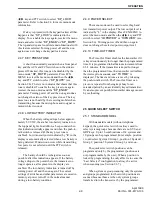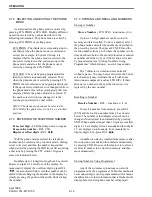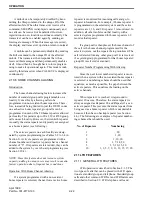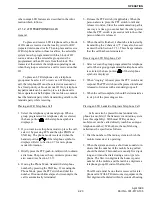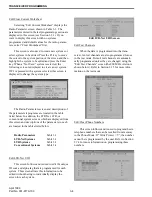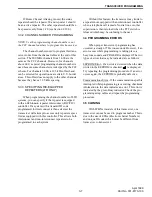
OPERATION
2-21
April 1999
Part No. 001-8170-100
need to be enabled. However, if it is enabled, an LTR-
Net system must be selected. If an LTR or conven-
tional system is selected, roaming is disabled and LTR-
Net systems are not scanned.
Registering on a New Locality
When roaming is initially enabled or power is
turned on, the status channel of the currently selected
system is monitored for a free channel. When one is
decoded, a registration message is sent. This message
includes the mobile’s unique ID and the home repeater
to be used. The registration information is forwarded to
the System and Subscriber Manager which then knows
its location.
If the signal from a locality is weak (see Dropout
and Capture Criteria which follows), or if two unsuc-
cessful access attempts are made with the double no
access feature enabled (see Table 3-1), the transceiver
begins searching for another locality. When this is
occurring, “LC SRCH” is displayed.
Up to five preferred localities can be programmed
(see Table 3-2). These localities are always searched
first and in the programmed order when automatic
locality search is initiated. If none of the preferred
localities could be accessed or none are programmed,
the other programmed LTR-Net localities are searched.
Over-the-air programming can be used to add or
change but not delete preferred localities.
NOTE: De-registering does not occur with this radio.
Revert System/Group Selection After Registration
After registration on a new locality occurs, “LC
SRCH” is no longer displayed, and the system of the
accessed locality is displayed. If one of the preferred
localities is accessed, it is the system of that locality.
Otherwise, it is the next higher system programmed
with the locality that could be accessed (wrap-around
occurs after the highest system is checked). The
selected group is the last selected group of that system.
A call can be received on a new locality before registra-
tion occurs if the call is already active on that locality.
Dropout and Capture (Pick- Up) Criteria
The receive signal level at which registration on
another locality is triggered is controlled by a program-
mable system parameter called Dropout Criteria. This
parameter is programmable for 50-100% with a default
setting of 75%. This parameter sets the percentage of
good data messages that must be received over a sam-
pling period to avoid entering the task that searches for
a new locality. Therefore, the higher the programmed
percentage, the sooner roaming occurs.
The receive signal level that must be detected on a
new locality before registration is attempted is
controlled by a programmable system parameter called
Capture (Pick-Up) Criteria. It is programmable for 50-
100% with a default setting of 80%. This parameter
sets the percentage of good data messages that must be
received over a sampling period. Therefore, the higher
the percentage, the stronger the signal must be for
registration to be attempted. Note that the transceiver
uses the value programmed for the locality being
sampled, not the value programmed for the locality on
which it is currently registered.
The difference between the Dropout and Capture
Criteria percentages establishes a signal hysteresis
between the current and a new locality. The Capture
percentage should be set higher than the Dropout
percentage. This prevents registration on a new site
with a weaker signal than the current site. It also
prevents registration on the same site that was lost.
2.10.4 OVER-THE-AIR LOCALITY CHANNEL
UPDATES
Localities (systems in this transceiver) are initially
programmed with the channel numbers of all repeaters
currently in use. These are then the channels that the
transceiver can access when placing and receiving
calls. If new channels are later added to a locality,
over-the-air programming is used to update the trans-
ceivers with the new channels. This eliminates the
need to bring them in for reprogramming. Channel
updates occur on only selected repeaters, and they are
initiated automatically by the radio system. While
channels are being updated, “
PROG CH
” is displayed.
2.10.5 TRANSCEIVER DISABLE
If a mobile is lost or stolen or is being used to
interfere with communication, it can be temporarily or
permanently disabled by the system operator.



